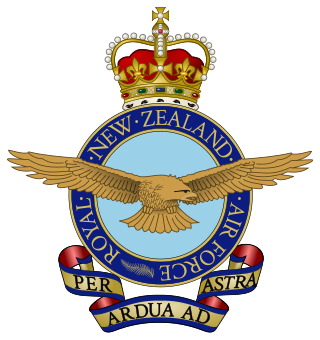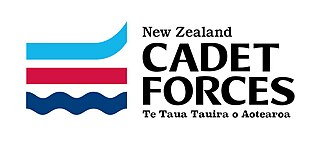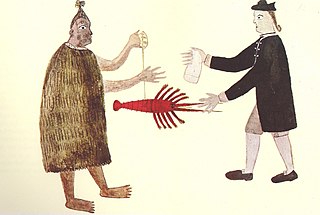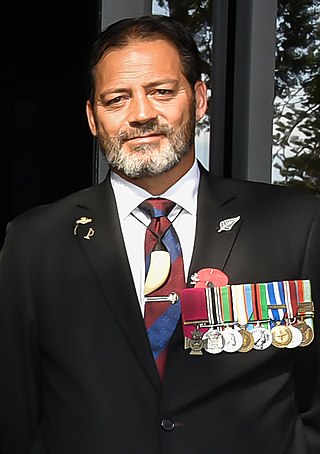The New Zealand Defence Force is the three-branched military of New Zealand. The NZDF is responsible for the protection of the national security of New Zealand and her realm, promoting its interests, safeguarding peace and security, as well as supporting peacekeeping and humanitarian missions. It consists of three services: the Royal New Zealand Navy (RNZN), the New Zealand Army and the Royal New Zealand Air Force (RNZAF), as well as tri-service components. As of June 2023, the NZDF has a strength of 14,996 employees, consisting of 8,669 regular force personnel, 3,260 reserve force personnel and 3,067 civilian members. It is supported by the New Zealand Ministry of Defence (MOD) and is commanded by the Chief of Defence Force (CDF).

The Royal New Zealand Air Force is the aerial service branch of the New Zealand Defence Force. It was formed initially in 1923 as a branch of the New Zealand Army, being known as the New Zealand Permanent Air Force, becoming an independent air force on 1 April 1937.

The New Zealand Air Training Corps is one of the three corps in the New Zealand Cadet Forces (NZCF), alongside the New Zealand Sea Cadet Corps and the New Zealand Cadet Corps. It is funded in partnership between the Royal New Zealand Air Force (RNZAF) and local communities. Members are civilians with no obligation to enlist in the New Zealand Defence Force (NZDF). Should a cadet enlist, their service in the ATC cadet does not translate into higher pay, rank, or seniority.

The New Zealand Cadet Forces is a voluntary military-style training organisation for New Zealand youth between the ages of 13 and 21. Run in partnership with the New Zealand Defence Force (NZDF) and local community organisations. Through its three branches, the New Zealand Cadet Forces provide young adults with a four-year training curriculum, while a number of local, area, and national camps and courses provide further experience and qualifications. It is jointly funded by the Ministry of Defence, the Royal New Zealand Returned Services' Association, local communities, and the Associated charities belonging to each branch. Overall it is directed by Air Marshal Kevin Short, Chief of Defence Force. Cadets are not under any obligation to join the New Zealand Defence Force, however many choose to do so upon turning 18 years old.

The New Zealand Army is the principal land warfare force of New Zealand, a component of the New Zealand Defence Force alongside the Royal New Zealand Navy and the Royal New Zealand Air Force.

No. 40 Squadron RNZAF is a transport squadron in the Royal New Zealand Air Force (RNZAF). Established in June 1943, it remains on active duty.

The military history of New Zealand is an aspect of the history of New Zealand that spans several hundred years. When first settled by Māori almost a millennium ago, there was much land and resources, but war began to break out as the country's carrying capacity was approached. Initially being fought with close-range weapons of wood and stone, this continued on and off until Europeans arrived, bringing with them new weapons such as muskets. Colonisation by Britain led to the New Zealand Wars in the 19th century in which settler and imperial troops and their Māori allies fought against other Māori and a handful of Pākehā. In the first half of the 20th century, New Zealanders of all races fought alongside Britain in the Boer War and both World Wars. In the second half of the century and into this century the New Zealand Defence Force has provided token assistance to the United States in several conflicts. New Zealand has also contributed troops extensively to multilateral peacekeeping operations.
The following lists events that happened during 1978 in New Zealand.

Lieutenant General Sir Jeremiah Mateparae is a former New Zealand soldier who served as the 20th governor-general of New Zealand between 2011 and 2016, the second Māori person to hold the office, after Sir Paul Reeves. A former officer in the New Zealand Army, he was the Chief of the Defence Force from 2006 to 2011, and then served as the director of the New Zealand Government Communications Security Bureau for five months in 2011. Following his term as governor-general, Mateparae was the high commissioner of New Zealand to the United Kingdom between 2017 and 2020.

Bill Henry "Willie" Apiata, VC is an honorary warrant officer class one in the New Zealand Army Reserve Forces. As a corporal in the New Zealand Special Air Service, he became the first recipient of the Victoria Cross for New Zealand. He received the award on 2 July 2007 for bravery under fire during the War in Afghanistan in 2004, in which he carried a gravely wounded comrade across a battlefield, under fire, to safety.
The following lists events that happened during 2011 in New Zealand.

The Bridge of Remembrance is one of two main war memorials in Christchurch, New Zealand. It is dedicated to those who died in World War I, and serves as a memorial for those who participated in two World Wars as well as subsequent conflicts in Borneo, Korea, Malaya, and Vietnam. Owned by Christchurch City Council, it is located on the Cashel Street Bridge at the head of City Mall. The Bridge of Remembrance was repaired and strengthened following the 2011 Christchurch earthquake and was reopened with a rededication ceremony held on Anzac Day in 2016.
The following lists events that happened during 2012 in New Zealand.
The following lists events that happened during 2013 in New Zealand.
The following lists events that happened during 2014 in New Zealand.
The following lists events that happened during 2015 in New Zealand.

Dame Patricia Lee Reddy is a New Zealand lawyer and businesswoman who served as the 21st governor-general of New Zealand from 2016 to 2021.
The 2011 Special Honours in New Zealand were two Special Honours Lists, published in New Zealand on 20 May and 17 August 2011. Appointments were made to the New Zealand Order of Merit and the Queen's Service Order to recognise the incoming governor-general, Jerry Mateparae, and the outgoing vice-regal consort, Susan, Lady Satyanand.

The Hororata Highland Games is an annual event held in Hororata, New Zealand. The Games began in 2011, following the 2010 Canterbury earthquake. The Hororata community had a desire to make a positive change following the damage of the Canterbury earthquakes. The annual event has increased in popularity with 10,000 people coming to the 2016 edition. It has since become New Zealand's biggest Scottish festival.











